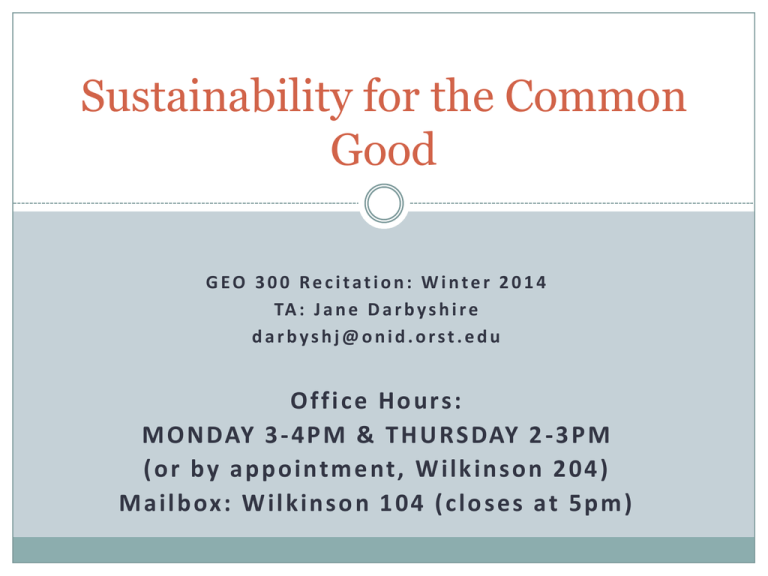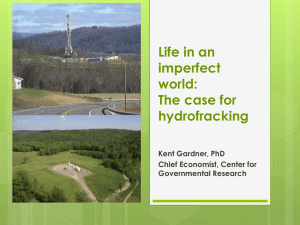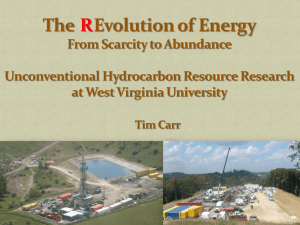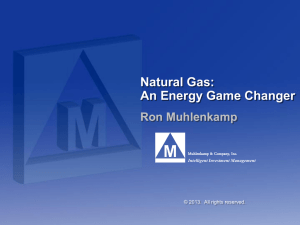Sustainability for the Common Good
advertisement

Sustainability for the Common Good GEO 300 Recitation: Winter 2014 TA : J a n e D a r b y s h i r e darbyshj@onid.orst.edu O f f i c e H o u rs : M O N DAY 3 - 4 P M & T H U RS DAY 2 - 3 P M ( o r by a p p o i nt m e nt , W i l k i n s o n 2 0 4 ) M a i l b ox : W i l k i n s o n 1 0 4 ( c l o s e s at 5 p m ) Recitations Week 1 Intro Critical Thinking (CT) Papers Turn in Assignment #1 Carbon Footprint (Friday sections only) Week 3 CT Paper Workshop Week 7 Group Project Work Day Weeks 8, 9, 10 Group presentations Critical Thinking Papers INSTRUCTIONS AND TIPS TO HELP YOU SUCCEED! http://www.geo.oregonstate.edu/classes/geo300/ct w14.html Paper Format Heading Title Interpretation Analysis Evaluation Inference Explanation Self-regulation Works cited (must be 21st century (2000 & later accepted) Example topic… Prompt: "Natural gas production in the US has increased dramatically, mostly because of the "fracking" technique to release gas from rock deep underground. Natural gas prices have plummeted, resulting in more natural gas power plants, fewer wind turbine farms, less coal being burned. But natural gas is still a hydrocarbon fossil fuel, and each cubic foot we burn puts more carbon dioxide in the atmosphere. Take a facet of this topic and run with it." Heading Include Example Name Student ID # Question # GEO 300 Recitation day/time (W8, F10, F12) TA Name (Jane Darbyshire) CT# and due date Word count total, plus subtotals for analysis and for other combined sections Jane Example ID NUMBER QUESTION 1-1 GEO 300, Fall ‘13 TA: Jane CT#1 due 1/9/201 Word Count: 549 (Analysis: 405 ; Other: 144) Title Instructions Example I should be able to tell The precautionary your topic and your position from the title. You can make it clever/witty but don’t be offensive. principle and Marcellus hydrofracking: Why policymakers should rethink the loose regulations around injecting mutagenic cancer-water into our communities Interpretation Instructions Example This is your very short Recently, natural gas extraction introduction paragraph. Introduce why the topic is important, explain it very simply (if needed), and then conclude with your thesis statement. Thesis statement: your argument/position on the topic and how you will support your position.** in the Marcellus Shale region became economically profitable due to advances in hydrofracturing, which involves injecting high-pressured water solution into the ground to break shale and release gas. However, because hydrofracking is unproven and potentially harmful to both humans and the environment, policymakers must exercise the precautionary principle. ** It doesn’t matter what your opinion is, only that you support it with a well-written essay that follows the instructions. Analysis Instructions Use peer-reviewed literature to form an argument and support your position. Come up with 2 or 3 main points for your argument. Write a short paragraph for each one, citing your PR lit. Don’t waste space explaining details of what something is or how it works. Example Three points: Hydrofracking is not proven to be safe, and may be dangerous. Hydrofracking can lead to environmental harm. Hydrofracking can harm people and communities. Each of these points supports the thesis about using the ‘precautionary principle’ and regulating hydrofracking. Example Analysis Policymakers should restrict Marcellus Shale development because hydrofracking’s safety is unproven. In fact, outside flawless execution, hydrofracking will cause harm. Transportation spills, well leaks, groundwater leaching, site discharge, and poor wastewater disposal can all lead to water contamination (Rozell & Reaven, 2011; p. 1391). Contamination is an issue if the frackwater is dangerous, but scientists cannot confirm or deny the danger because drilling companies keep the frackwater additives undisclosed (Engelder, Howarth, & Ingraffea, 2011; p. 271; Kargbo, Wilhelm, & Campbell, 2010; p. 5681). Finally, the development is happening faster than scientists can study the full social-environmental impacts, thus fleecing policymakers who will not realize the danger until it is too late (Engelder et al., 2011; p. 271). What scientists have learned about hydrofracking suggests that it can devastate the environment. First, hydrofracking requires development of roads, wells, and retention ponds, requiring resource use and causing environmental disturbance (Kargbo et al., 2010; pp. 5680-81). Then, it requires massive water withdrawals from local rivers, which upsets the balance in freshwater ecosystems disturbance (Kargbo et al., 2010; p. 5681). Furthermore, dangerous contamination from hydrofracking additives can happen when frackwater leaches into surface or groundwater, or if it is improperly disposed/reused (Kargbo et al., 2010; p. 5681). Marcellus Shale, particularly, produces risky quantities of arsenic and selenium in hydrofracking wastewater (Balaba & Smart, 2012; p. 1441). Even air quality is affected by hydrofracking, which produces toxic, carcinogenic air pollutants and elevated levels of ground-level ozone (Engelder et al., 2011; p. 271). Thus, even if unintended pollution and seepage are avoided, Marcellus gas extraction still harms the local environment via its infrastructure, water consumption, and air pollution. Example Analysis Finally, policymakers should regulate Marcellus hydrofracking because of its human costs. The environmental contamination can have profound effects on human health (e.g. cancer, death, mutations), particularly if frackwater enters drinking water supplies; yet, no public health experts are included in Marcellus advisory commissions (Goldstein, Kriesky, Pavliakova, 2012; p. 483). Furthermore, the boom in shale development destabilized communities, increasing traffic, degrading infrastructure, decreasing quality of life, and creating conflict (Pifer, 2011; p. 625; Weigle, 2011; p. 7). Issues with the leasing process, fairness of lease terms/payments, and encroachment on adjacent property rights have all emerged due to underdeveloped regulations and inadequate case law surrounding gas exploitation (Pifer, 2011; p. 628; Lamarre, 2011; p. 457). In sum, hydrofracking has negative effects on human health and wellbeing, and current legal/regulatory structures are insufficient to protect communities. Use topic sentences and conclusion sentences in your paragraphs to give them focus. Support your subpoints with evidence. Evaluation Instructions Write a sentence explaining the bias of authors of at least TWO of your sources. Be specific. Tip: Look for authors’ bios. Where did they work? Who funded their research? When mentioning the bias, indicate how they might be biased. Alternative: limitation of two articles. Example Kargbo, Wilhelm, and Campbell all work for the EPA, which is constantly threatened due to gas company lobbyists. Weigle and Rozell worked for state DECs, giving them conservationist, proregulation biases. Inference Instructions Think of some consequence of your topic that you haven’t already talked about. What if? Think outside the box. If this (or that) does (or doesn’t) happen, then… Make a prediction. Think of a specific situation, ecosystem, or population for your inference. Example Hydrofracking will create a boom and bust in the Marcellus region, leaving communities with abandoned sites, fewer jobs, and degraded ecosystems. Hydrofracking is a distraction, and it is slowing investment and advancement in greener energy technology. Explanation Instructions Concise conclusion Remind us of your thesis statement and how you’ve proved your point. Example Policymakers must implement regulations on Marcellus exploitation to curtail further environmental and human harm. Decisionmakers must exercise the precautionary principle, forcing drillers to prove their safety and remain accountable. Self-regulation Instructions Think of your own bias. Why did you take the position you did? Dig deep! Example “I grew up in Pennsylvania, where my family and friends still live.” [Pennsylvania is affected by the issue, so living there in turn affects the author’s opinions] Reference List 101 Basic form (use author order from the article!*) Author, A. A., Author, B. B., & Author, C. C. (Year). Title of article. Title of Periodical, volume number(issue number), pages. Three to seven authors Kernis, M. H., Cornell, D. P., Sun, C. R., Berry, A., Harlow, T., & Bach, J. S. (2003). There's more to self-esteem than whether it is high or low: The importance of stability of self-esteem. Journal of Personality and Social Psychology, 65(1), 1190-1204. More than 7 authors: After the sixth author's name, use an ellipses in place of the author names. Then provide the final author name. There should be no more than seven names. Miller, F. H., Choi, M. J., Angeli, L. L., Harland, A. A., Stamos, J. A., Thomas, S. T., . . . Rubin, L. H. (2009). Web site usability for the blind and low-vision user. Technical Communication, 57(4), 323-335. Source: Purdue OWL for APA OTHER FORMATS (MLA etc) ARE OK, BUT BE CONSISTENT! Reference List 101 Do not use “et al” to replace author names in your references section no matter what format you choose to use. Journal articles you found in an online database that are published in a print Journal (even if you access the content online) are NOT “web resources” and should not be referenced as such. Do not include the long, crazy EBSCO (or other database) URL to the article. That expires, and you will lose some formatting points. Reference List 101 Pay attention to: Capitalization of title Capitalization of Journal Name Italicize Journal Name & Vol. # Keep list of authors in the same order as they appear in the article. Alphabetize the listings by first author’s last name. Barnes, T. (2005). A fistful of paintballs. Journal of Community, 4(1), 12-36. Chang, B.F., Barnes, T., & Perry, B. (2005). The first Chang dynasty. Journal of Community, 2(1), 32-66. Nadir, A., Edison, A., & Hawthorn, P (2012). Digital estate planning. Journal of Community, 69(20), 19-24. Winger, J. & Nadir, A. (2011). Remedial chaos theory. Journal of Community, 3(3), 1-7. Citations 101 A Work by Two Authors: Research by Wegener and Petty (2004; p. 117) supports... (Wegener & Petty, 2004; p. 117) A Work by Three to Five Authors: List all the authors in the signal phrase or in parentheses the first time you cite the source. (Kernis, Cornell, Sun, Berry, & Harlow, 2003; pp. 33-37) In subsequent citations, only use the first author's last name followed by "et al." in the signal phrase or in parentheses (Kernis et al., 2003; p. 39). In et al., et should not be followed by a period. Six or More Authors: Use the first author's name followed by et al. in the signal phrase or in parentheses. Harris et al. (2001; p. 221) argued... (Harris et al., 2001; pp. 221-223) For ALL citations: add the page number(s) on which you found the info (needs to match article page interval). Punctuation goes AFTER the citation (Watson, 2013; p. 452). Using your sources in-text AVOID: Watson (2012; pg. 1) argues that “using lots of quotations can be tedious for the reader, especially when the exact wording of the idea is not particularly important.” PLAGIARISM: Using lots of quotations can be tedious for the reader, and thus, we should paraphrase (Watson, 2012; p. 1). Not plagiarized, but it would flow better if paraphrased. Did not use quotation marks around the quoted part. PLAGIARISM: Direct quotations bog down text. Used an idea from a source, but did not cite it BETTER, but still avoid: Watson (2012; pg. 1) argues that direct quotations can be superfluous. Paraphrased… but in these papers, we don’t want you to waste space talking about the authors. Instead, simply paraphrase the results that support your position. BEST: Direct quotations complicate essays unnecessarily (Watson, 2012; p. 1). Paraphrasing helps your ideas flow more smoothly. Finding PR Sources Acceptable Sources: • books or PR journal articles • published from 20002013 Good Source (PR, has all the info you need) Not Great, but Okay (no author- real PR articles are longer & have authors listed… but this is acceptable as long as it comes up in the PR search) Making your References/Citations Reference listing: 7 or fewer authors, must list all In text: More than 5 authors, use et al. every time Rahm, B. G., Bates, J. T., Bertoia, L. R., Galford, A. E., Yoxtheimer, D. A., & Riha, S. J. (2013). Wastewater management and Marcellus Shale gas development: Trends, drivers, and planning implications. Journal of Environmental Management, 120, 105-113. Here, I summarized information from the article in my own words (Rahm et al., 2013; p. 110-111). Avoid Getting a Zero There are four ways to guarantee yourself a ZERO SCORE on the paper How to avoid the zero. 1. Unacceptable sources. 2. Not properly citing all four of your primary sources in the text of your paper. 3. Not meeting the word counts. 4. Not using the required format, i.e., Interpretation, Analysis, Evaluation, etc. Cite at least 4 peer-reviewed sources from the 21st century (2001 on) Cite every fact or idea you use with an in-text citation and reference listing. Don’t copypaste ANYTHING or copy exact wording. Must be 400-450 words in Analysis and 100-150 words in all other sections combined… Make sure the TOTAL doesn’t add up to more than 550. Use headings, and don’t forget any sections. Learning to be concise: It’s hard. Before In the last decade, natural gas extraction in the Marcellus Shale region became economically profitable due to advances in hydrofracturing (also: hydrofracking, fracking) technology. Hydrofracking involves injecting highpressured water solution into the ground, thus breaking the shale and releasing pockets of gas. Hydrofracking has led to a boom in development. However, because hydrofracking is unproven and potentially harmful to both humans and the environment, policymakers must exercise the precautionary principle. After Recently, natural gas extraction in the Marcellus Shale region became economically profitable due to advances in hydrofracturing, which involves injecting high-pressured water solution into the ground to break shale and release gas. However, because hydrofracking is unproven and potentially harmful to both humans and the environment, policymakers must exercise the precautionary principle. Logistics Must be typed, legible Print on front and back of 1 piece of paper (-2 if you don’t, +1 bonus if you do) Attach correct grading half-sheet (or -15) Available on the website Initial grading half-sheet (or -5) Bring a final copy to week 3 recitation. Schedule Recitations: Weeks 1, 3, 7, 8, 9, 10 Week 4: MWF Sections: CT #1 Final Due Monday January 27th (in lecture) Week 3: Bring CT#1 near- final draft (Recitation workshop) Wednesday Night Section: CT #1 Final Due Friday January 24th (TA Mailbox) Week 6: CT#2 due (in lecture) Week 7: Group Project Work Day in Recitation Schedule Week 8: Energize Corvallis Due (Feb 28) Group Project Presentations (recitation) Week 9: CT#3 due Group Project Presentations (recitation) Week 10: Group Project Presentations (recitation) The Contract I understand that I will receive an undisputable zero score on my CT paper: If I have more than 550 total words in my paper If my analysis section is less than 400 or greater than 450 words If my other combined sections (besides analysis) have word counts less than 100 or greater than 150 If I do not reference at least four peer-reviewed sources (journal articles or books) published between 2000 and 2013 If I don’t cite all my sources correctly in the body of my paper, or if I plagiarize If I do not follow the format of the paper (with all the appropriate sections and subheadings) Furthermore, I understand that: Newspapers, magazines, and websites are not peer-reviewed sources. Not every source on EBSCO or OSU libraries is peer-reviewed, and I must take precautions to narrow the search to PR-only sources. The “ways to get a zero” (word count limits, PR source requirements) are completely rigid and inflexible. E.g. If I cite 1 of 4 sources from 1999, I have failed to meet the PR source requirement, and I will get a zero on my paper. Not realizing that I didn’t meet the requirements (a bad source I thought was good, a miscalculated word count, etc.) does not exempt me from the zero score. Signing up for this class means that I am beholden to the course/assignment rules, and staying in the class implies that the rules apply to me. I can drop the class if I do not like the rules, but the rules will not be changed for me. My TA wants to help me succeed, and she can provide lots of helpful feedback BEFORE I turn in my paper. My sad story (“but I won’t be able to graduate!” “but I will lose my scholarship!” ) will make my TA very sad, but she will not be able to [she is not allowed to] change my score out of pity. Thus, I verify that: I, and I alone (not my TA or anyone else), am responsible for my score on CT papers. I will do everything in my power to avoid a zero and submit papers that meet all requirements. I will get help before the paper is due rather than after. I won’t beg for a score if I get a zero, but instead will learn from my mistakes and do better next time. I won’t harass Steve/my TA about these rules, because I have full knowledge of them ahead of time, and I am voluntarily remaining in the class anyways.





